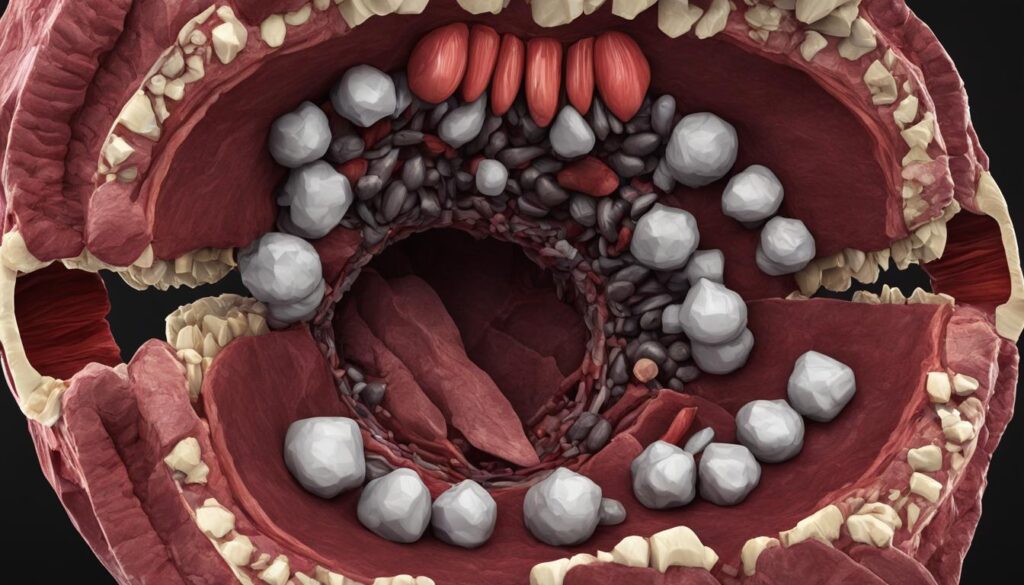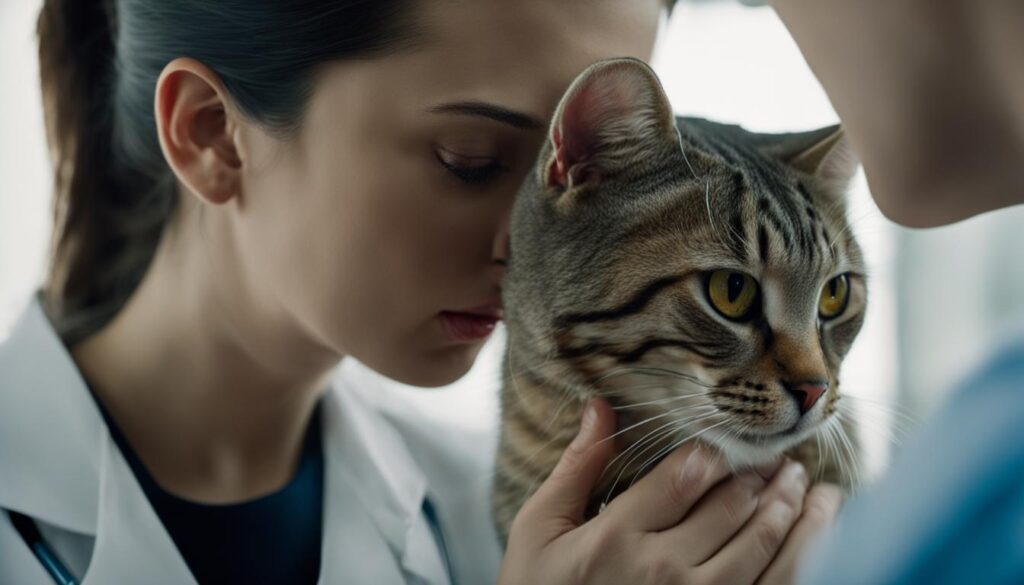Have you ever wondered if dogs have tonsils? It’s a common question among pet owners, and the answer is yes! Dogs do have tonsils, although they may not be as noticeable as human tonsils. Understanding the role and function of these canine tonsils can help us better care for our furry friends’ health.
Dog tonsils are similar to lymph nodes and are located in the back of the throat. They play a vital role in fighting infection by trapping and destroying bacteria and other harmful pathogens. Just like in humans, dog tonsils can become inflamed and enlarged, a condition known as tonsillitis.
Tonsillitis in dogs is more commonly seen in small breeds and is usually secondary to another disease or condition affecting the mouth or throat. Causes of tonsillitis can range from chronic vomiting and coughing to dental issues and bacterial infections. In some cases, tonsillitis in dogs can be a sign of an underlying health concern that requires attention.
The treatment for tonsillitis in dogs typically involves a combination of antibiotics to help clear the infection and addressing any underlying issues causing the condition. In severe or recurring cases, a tonsillectomy, which is the surgical removal of the tonsils, may be recommended. However, this procedure is considered a last resort and is rarely performed.
While tonsillitis in dogs can be concerning, prompt veterinary care and proper treatment can help alleviate symptoms and support your pet’s recovery. Monitoring your dog’s throat health and addressing any signs of tonsillitis is crucial for their overall well-being.
Key Takeaways:
- Dogs do have tonsils, which are located in the back of their throat.
- Canine tonsils play a crucial role in fighting infection.
- Tonsillitis in dogs is more common in small breeds and is usually secondary to other diseases or conditions affecting the mouth or throat.
- Treatment for tonsillitis in dogs involves antibiotics and addressing any underlying issues.
- Tonsillectomy, the removal of the tonsils, is rarely recommended and reserved for severe or recurring cases.
The Role and Location of Canine Tonsils

Canine tonsils are small, glandular structures located in the back of the throat, similar to human tonsils. They play a crucial role in the dog’s immune system and overall health.
The tonsils are situated in small pouches or crypts at the back of the throat, adjacent to the base of the tongue. This location allows them to detect and trap bacteria, viruses, and other pathogens that enter the dog’s mouth and throat. By capturing these harmful microorganisms, the tonsils help prevent them from spreading further into the body.
The function of canine tonsils is primarily to fight infection. They contain specialized cells, including lymphocytes, that actively work to destroy pathogens. These cells produce antibodies that target and eliminate harmful bacteria and viruses, promoting the dog’s immune response and protecting against illness.
When the tonsils become inflamed or infected, a condition known as tonsillitis, they may enlarge and become visible at the back of the throat. Tonsillitis can be caused by various factors, such as bacterial or viral infections, allergies, or other underlying health issues. It can lead to symptoms such as swelling, redness, pain, difficulty swallowing, and bad breath.
| Tonsil Location | Tonsil Function |
|---|---|
| Located in the back of the throat | Fights infection by capturing and destroying bacteria and other pathogens |
Tonsillitis in Dogs: Causes and Symptoms

Tonsillitis in dogs is a common condition that can cause discomfort and affect their overall health. It is usually secondary to another disease or condition, such as chronic vomiting, a chronic cough, or chronic mouth disease. Additionally, tartar accumulation on the teeth and associated bacterial infections can also lead to tonsillitis.
Dogs with tonsillitis may exhibit various symptoms that indicate inflammation and infection in the throat. These symptoms include:
- Pain: Dogs may show signs of discomfort, such as excessive drooling, pawing at the mouth, or reluctance to have their throat touched.
- Gagging: Tonsillitis can cause dogs to gag or retch as a result of the irritated tonsils.
- Difficulty swallowing: Swollen tonsils can make it challenging for dogs to swallow, leading to reluctance or difficulty eating.
- Reluctance to eat: Dogs with tonsillitis may lose their appetite due to pain and swallowing difficulties.
- Decreased activity: Dogs may become lethargic or less active than usual when they are experiencing tonsillitis.
Unlike humans, dogs usually do not have a fever with tonsillitis, which can make it challenging to recognize the condition without proper veterinary evaluation.
Understanding the causes and symptoms of tonsillitis in dogs is crucial for early detection and appropriate treatment. If you suspect your dog has tonsillitis, it is essential to seek veterinary care to alleviate their discomfort and address any underlying issues.
Treating Tonsillitis in Dogs
When it comes to treating tonsillitis in dogs, it is crucial to address the underlying cause. This may involve treating infections or dental disease that contribute to the inflammation of the tonsils. In most cases, antibiotics are prescribed for a period of two to three weeks to target the tonsils and the primary infection.
In addition to antibiotics, anti-inflammatory treatment may be recommended to alleviate pain and reduce swelling in the throat. This can help improve the dog’s overall comfort and facilitate the healing process.
Tonsillectomy, the surgical removal of the tonsils, is rarely recommended for dogs with tonsillitis. It is typically reserved for severe cases that do not respond well to other treatment options or when tonsillitis becomes a recurring problem despite conservative management.
It is important to note that dental treatment plays a significant role in the management of tonsillitis in dogs. Poor dental hygiene and associated bacterial infections can contribute to the development of tonsillitis. Therefore, dental care, including regular brushing, professional cleanings, and addressing any underlying oral health issues, is essential in preventing and managing tonsillitis in dogs.
Comparison of Treatment Options for Tonsillitis in Dogs
| Treatment Option | Description |
|---|---|
| Antibiotics | Prescribed for two to three weeks to target the tonsils and underlying infection. |
| Anti-inflammatory medication | Recommended to reduce pain and swelling in the throat. |
| Tonsillectomy | Rarely recommended, reserved for severe or recurring cases that do not respond to other treatments. |
| Dental treatment | Essential for preventing and managing tonsillitis, including regular brushing and addressing oral health issues. |
Tonsillitis in Small Breeds of Dogs

Tonsillitis is a common condition in dogs, and it tends to affect small breeds more frequently than larger breeds. Small breed dogs, especially puppies, are more susceptible to developing primary tonsillitis without an underlying cause.
Recurring tonsillitis is also more likely to occur in small breeds. These dogs may experience repeated episodes of tonsillitis, which can be bothersome and impact their overall health and well-being.
It is important to note that despite the prevalence of tonsillitis in small breeds, removal of the tonsils is generally not recommended unless absolutely necessary. Tonsils play a vital role in fighting infection and are an essential part of the dog’s immune system.
Removing the tonsils can compromise the dog’s ability to combat pathogens effectively, leaving them more susceptible to future infections. Therefore, it is essential to explore alternative treatments and management strategies for tonsillitis in small breed dogs, focusing on reducing inflammation, addressing underlying causes, and promoting overall throat health.
Proper veterinary care and regular check-ups are crucial for monitoring the condition and ensuring the optimal health of small breed dogs prone to tonsillitis.
| Tonsillitis in Small Breeds | Primary Tonsillitis in Dogs | Recurring Tonsillitis |
|---|---|---|
| Tends to affect small breeds more frequently | Small breed dogs can develop primary tonsillitis without an underlying cause | Recurring episodes of tonsillitis are common in small breeds |
| Small breeds, especially puppies, are more susceptible | Removal of tonsils is generally not recommended | Removing tonsils may compromise the dog’s immune system |
| Regular veterinary care and check-ups are crucial for monitoring the condition | Alternative treatments and management strategies should be explored | Promoting overall throat health is important |
Tonsillitis and Contagion

Tonsillitis in dogs is typically caused by bacteria that are naturally present in the mouth, which makes it unlikely to be contagious. However, dogs can acquire a transient infection with Streptococcus bacteria if they come into contact with a human who has strep throat. In such cases, it is recommended to treat dogs with infected tonsils with antibiotics, especially if there are recurring infections in the household.
Treating tonsillitis in dogs involves addressing the underlying bacterial infection and providing appropriate medical care to alleviate symptoms. Antibiotics are commonly prescribed to fight the infection and reduce inflammation, helping the tonsils heal. It is essential to follow the veterinarian’s instructions regarding medication dosage and duration to ensure effective treatment.
If your dog has been in contact with a person diagnosed with strep throat, be observant for any signs or symptoms of tonsillitis, such as difficulty swallowing, pain, loss of appetite, or changes in behavior. Prompt veterinary attention is advised if you suspect your dog may have acquired a contagious form of tonsillitis.
“While tonsillitis in dogs is usually not contagious, it is always better to err on the side of caution and seek veterinary advice if you suspect your dog may have been exposed to strep throat.”
Tonsillitis in Cats and Other Animals

Cats, like dogs and many other animals, can also develop tonsillitis. In fact, cats have four sets of tonsils, each serving a different purpose in their anatomy. These tonsils include the pharyngeal tonsils, palatine tonsils, lingual tonsils, and paraepiglottic tonsils.
Other animals also possess tonsils, although the location and function may vary among species. For example, sheep, goats, oxen, pigs, horses, rabbits, rats, and pigeons all have tonsils. While some similarities exist in their role in the immune system, each species may have unique adaptations and variations in the location and function of their tonsils.
Understanding tonsillitis in cats and other animals is crucial for their overall health and well-being. By recognizing the signs and symptoms, pet owners can seek appropriate veterinary care and treatment, ensuring a swift recovery and a happier, healthier animal companion.
Tonsillitis in Cats: Symptoms and Treatment

Infections and inflammation of the tonsils can also affect our feline friends. Tonsillitis in cats is characterized by various symptoms that indicate discomfort and difficulty in the throat area. Recognizing these symptoms and seeking prompt veterinary attention is crucial for the well-being of our beloved cats.
Symptoms of Cat Tonsillitis
Cats with tonsillitis may exhibit the following symptoms:
- Loss of appetite
- Difficulty swallowing
- Drooling
- Fever
- Enlarged lymph nodes
- Swollen tonsils
These symptoms can vary in severity depending on the individual cat and the underlying cause of the tonsillitis.
Treatment of Cat Tonsillitis
The treatment of tonsillitis in cats involves addressing the underlying cause and providing appropriate medical intervention. This may include:
- Administering antibiotics to combat bacterial infections
- Prescribing anti-inflammatory medications to reduce inflammation and pain
- Managing any allergies that may contribute to the development of tonsillitis
- Removing foreign bodies from the throat if necessary
Veterinary guidance is essential in diagnosing the cause of tonsillitis and determining the most effective treatment approach for each individual cat.
| Cat Tonsillitis Symptoms | Cat Tonsillitis Treatment |
|---|---|
|
|
Tonsillectomy in Dogs and Cats
Tonsillectomy, the surgical removal of the tonsils, is rarely recommended in dogs and cats. It is typically reserved for severe infections or suspected cancer. Although tonsillectomy techniques are available, there is limited information on their complications in dogs and cats. Pet owners should be aware of the risks associated with the procedure and consider alternative treatments before deciding on tonsillectomy.
While tonsillectomy can effectively treat severe infections or address concerns of potential cancer, it is a significant surgical procedure that carries certain risks. These risks include:
- Infection
- Pain and discomfort
- Bleeding
- Impaired healing
Additionally, like any surgery, there is always a risk of complications such as adverse reactions to anesthesia or damage to surrounding structures. Therefore, it is essential for pet owners to have a thorough discussion with their veterinarian to weigh the benefits against the risks and consider alternative treatments before proceeding with tonsillectomy.
Alternative Treatments to Consider
Before opting for tonsillectomy, pet owners should explore less invasive treatment options. These may include:
- Medication: Depending on the underlying condition and the severity of tonsillitis, antibiotics or other medications may be used to manage the infection and alleviate symptoms.
- Dental Care: In cases where dental disease contributes to tonsillitis, addressing the dental issues and maintaining good oral hygiene can help improve the health of the tonsils.
- Supportive Care: Providing proper nutrition, hydration, and rest can aid in the recovery from tonsillitis and reduce the frequency of infections.
By exploring these alternative treatments and working closely with a veterinarian, pet owners can make an informed decision that prioritizes their pet’s health and well-being.
| Treatment | Pros | Cons |
|---|---|---|
| Tonsillectomy | – Potential resolution of severe infections – Treatment for suspected cancer |
– Surgical risks – Limited information on complications – High cost – Recovery period |
| Medication | – Less invasive – Can effectively manage infections |
– May not address underlying causes – Potential side effects |
| Dental Care | – Improves overall oral health – Reduces risk of recurring infections |
– Requires regular maintenance – May not be effective in all cases |
| Supportive Care | – Enhances overall well-being – Supports immune system |
– Does not directly treat tonsillitis – May not prevent future infections |
Wrapping Up
Dogs do have tonsils, a vital part of their anatomy and immune system. These canine tonsils, located in the back of their throat, help fight off infections by trapping and destroying harmful bacteria and pathogens. Tonsillitis, while more common in small breeds, can occur in any dog, usually as a secondary condition to other mouth or throat issues.
Treating tonsillitis in dogs involves a combination of antibiotics and addressing the underlying cause. Dental disease and infections in the mouth or throat often contribute to the development of tonsillitis. Timely veterinary care and appropriate dental treatment can effectively manage the condition. Tonsillectomy, the removal of the tonsils, is rarely recommended and reserved for severe or recurring cases.
To ensure the overall health and well-being of dogs, monitoring their throat health is crucial. Any symptoms of tonsillitis, such as pain, difficulty swallowing, or decreased appetite, should prompt a visit to the veterinarian. By understanding the role of tonsils in their respiratory system and providing proper care, dog owners can help their canine companions maintain optimal health and prevent complications related to tonsillitis.
FAQ
Do dogs have tonsils?
Yes, dogs do have tonsils. Tonsils in dogs are similar to lymph nodes and play a role in fighting infection.
Where are canine tonsils located?
Canine tonsils are located in small pouches or crypts at the back of the throat, similar to human tonsils.
What causes tonsillitis in dogs and what are the symptoms?
Tonsillitis in dogs is usually secondary to another disease or condition affecting the mouth or throat. Symptoms include pain, gagging, difficulty swallowing, and decreased activity.
How is tonsillitis in dogs treated?
Treatment involves addressing the underlying cause and may include antibiotics, anti-inflammatory medication, and dental care.
Is tonsillitis more common in small breeds of dogs?
Yes, tonsillitis is more common in small breeds, especially puppies, but can occur in any breed of dog.
Can dogs spread tonsillitis to humans?
Tonsillitis in dogs is usually caused by bacteria that are normally present in the mouth, making it unlikely to be contagious. However, dogs can acquire a transient infection with Streptococcus bacteria from humans.
Can cats get tonsillitis?
Yes, cats can develop tonsillitis. They have four sets of tonsils – pharyngeal, palatine, lingual, and paraepiglottic tonsils.
What are the symptoms of tonsillitis in cats and how is it treated?
Cats with tonsillitis may experience symptoms such as loss of appetite, difficulty swallowing, and fever. Treatment involves addressing the underlying cause and administering appropriate antibiotics.
Is tonsillectomy recommended for dogs and cats with tonsillitis?
Tonsillectomy is rarely recommended and usually reserved for severe cases or suspected cancer. It should be considered as a last resort after other treatment options have been explored.
Do tonsils exist in other animals?
Yes, other animals such as sheep, goats, oxen, pigs, horses, rabbits, rats, and pigeons also have tonsils, although their location and function may vary.






